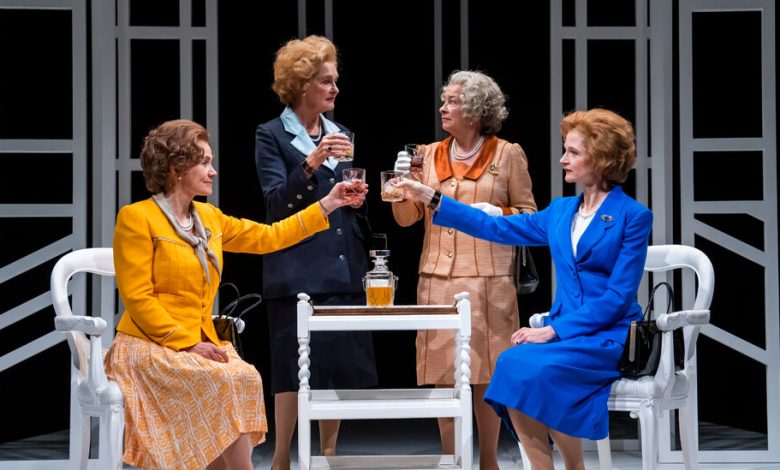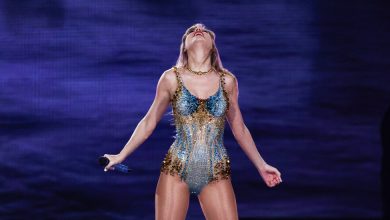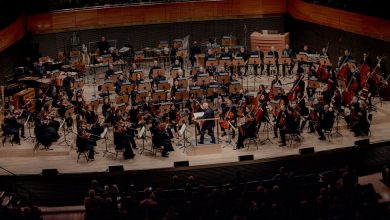At the End of Her Reign, the Queen Takes a Bow Onstage

LONDON — When the Kiln Theater planned its current revival of “Handbagged,” nobody knew how extraordinary the timing would turn out to be.
The 2013 play, by Moira Buffini, is one of a long line of dramas to put Queen Elizabeth II center stage. But its reopening during this period of mourning for the monarch turns out to serve the piece well, communicating a respect and affection for her memory that chime with the public mood. (The play’s first preview was Sept. 9, the day after the queen’s death.)
Plays can catch a moment, which is what “Handbagged” has done. Seeing Indhu Rubasingham’s production several days before the queen’s state funeral, I felt an audience connecting with the play with an intensity I didn’t sense duringits West End transfer in 2014.
Theater, a live art, can seem especially vital at times like this. Would it have felt as moving to be watching “The Crown” on TV that recent afternoon? I doubt it.
Several other playwrights have given voice to this essentially mysterious figure. Plays like Peter Morgan’s “The Audience” and Alan Bennett’s “A Question of Attribution” revealed the queen to be a great theatrical subject: wry and witty, her onstage intelligence feeding a sense among the public that so private a person always knew more than she let on.
Some Key Moments in Queen Elizabeth’s Reign
Becoming queen. Following the death of King George VI, Princess Elizabeth Alexandra Mary ascended to the throne on Feb. 6, 1952, at age 25. The coronation of the newly minted Queen Elizabeth II took place on June 2 the following year.
A historic visit. On May 18, 1965, Elizabeth arrived in Bonn on the first state visit by a British monarch to Germany in more than 50 years. The trip formally sealed the reconciliation between the two nations following the world wars.
First grandchild. In 1977, the queen stepped into the role of grandmother for the first time, after Princess Anne gave birth to a son, Peter. Elizabeth’s four children have given her a total of eight grandchildren, who have been followed by several great-grandchildren.
Princess Diana’s death. In a rare televised broadcast ahead of Diana’s funeral in 1997, Queen Elizabeth remembered the Princess of Wales, who died in a car crash in Paris at age 36, as “an exceptional and gifted human being.”
Golden jubilee. In 2002, celebrations to mark Elizabeth II’s 50 years as queen culminated in a star-studded concert at Buckingham Palace in the presence of 12,000 cheering guests, with an estimated one million more watching on giant screens set up around London.
A trip to Ireland. In May 2011, the queen visited the Irish Republic, whose troubled relationship with the British monarchy spanned centuries. The trip, infused with powerful symbols of reconciliation, is considered one of the most politically freighted trips of Elizabeth’s reign.
Breaking a record. As of 5:30 p.m. British time on Sept. 9, 2015, Elizabeth II became Britain’s longest-reigning monarch, surpassing Queen Victoria, her great-great-grandmother. Elizabeth was 89 at the time, and had ruled for 23,226 days, 16 hours and about 30 minutes.
Marking 70 years of marriage. On Nov. 20, 2017, the queen and Prince Philip celebrated their 70th anniversary, becoming the longest-married couple in royal history. The two wed in 1947, as the country and the world was still reeling from the atrocities of World War II.
Losing her spouse. In 2021, Queen Elizabeth II bade farewell to Prince Philip, who died on April 9. An image of the queen grieving alone at the funeral amid coronavirus restrictions struck a chord with viewers at home following the event.
“Handbagged” does much the same,loosely dramatizing the weekly meetings between the queen and her prime minister Margaret Thatcher — a ritual treated with much greater formality in “The Audience.”
The two match wits as women of power in a male-dominated world. But if Thatcher seemed the dominant figure at the time the play premiered, in 2013, the year of the former prime minister’s death, so the queen does now. What once felt like an extended caprice now feels weightier, not least when Thatcher late in the play praises the queen and her family as “a focus of patriotism, loyalty, affection and esteem.”
There is a time and place for lèse-majesté, or satire, but this isn’t it. Playing the queen’s older and younger selves, Marion Bailey and Abigail Cruttenden avoid caricature altogether, presenting the monarch as much cleverer, and also more compassionate, than her prime minister. (The invaluable Bailey, playing the older monarch, is the lone holdover from the play’s premiere.)
Naomi Frederick and Kate Fahy, playing the bossy, stubborn Thatcher in her youth and her prime, are both on predictably fiery, feisty form. And Romayne Andrews and Richard Cant complete the cast of six, bringing split-second timing to nearly 20 roles between them. Those include Ronald Reagan, sporting a cowboy hat, and Denis Thatcher, who asks the young queen if she would like a dance.
But perhaps the signature moment in the show comes when Cruttenden delivers part of the young Elizabeth’s famous birthday speech from 1947, in which the 21-year-old princess, soon to be queen, promised her subjects a lifetime of service, “whether it be long or short.” That address has been replayed countless times since the queen’s death, and its inclusion in “Handbagged” induces a palpable hush.
I recall less a hush than a gasp at “The Audience,” whose London audience was hungry for as much ceremony as Morgan’s play would allow. That happened most impressively in the 2013 production when Helen Mirren (who won an Oscar for a different portrayal of the monarch, in the movie “The Queen”) acted out her coronation, appearing onstage in full royal regalia.
Not every stage portrait has been so adoring (some might say sycophantic), but what is appropriate for one era doesn’t necessarily translate to another. I remember laughing heartily at the Royal Court debut of “The Queen and I,” the Sue Townsend play from 1992 in which the monarchy is disbanded and the royal family is dispatched to a housing project where the queen — shock, horror! — must learn, among other tasks, to dress herself. Here was something in which republicans could delight, but it’s difficult to imagine the play’s cheeky take on the queen-as-commoner currying much favor now.
Far more timely might be a revival of Bennett’s 1988 “A Question of Attribution.” The cunning one-act, written by a much-admired dramatist who is now in his 80s, finds the queen discussing forged paintings with Anthony Blunt, the royal art adviser whom she would subsequently strip of a knighthood when he was revealed to be a spy.
The implication in Bennett’s play is that an ever-shrewd queen understands considerably more about Blunt’s covert activities than she lets on: Her quiet, gentle wisdom underpins the play.
I’m not expecting to find onstage anytime soon a fresh production of “King Charles III,”Mike Bartlett’s so-called “future history play,” which has been superseded by the accession to the throne of the king.
Snarky and sometimes rude, the verse drama tells of a querulous prince stepping anxiously into the spotlight. We hardly need that story told in the theater, when it is happening in real life.
Handbagged. Directed by Indhu Rubasingham. Kiln Theater, through Oct. 29.




